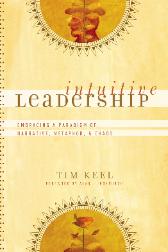I met Tim Keel in Uganda last year, where he and I attended a conference. It was about reconciliation, learning leadership lessons from Africa and about postmodern communities of faith. I spent some time with Tim, and really enjoyed his approach to life. At that point, he was just finishing up his latest book. It has now been released, to some acclaim.
Tim is a pastor of a church in the US. So, he writes from a faith community perspective. But his insights about leadership are universal and timely. I highly recommend his book. I have just got it, and am reading through it, so here is a review I received about his book.
 Intuitive Leadership: Embracing a Paradigm of Narrative, Metaphor, and Chaos
Intuitive Leadership: Embracing a Paradigm of Narrative, Metaphor, and Chaos
Buy it at Amazon.com
Book Review By Nanette Sawyer
I’ve been hungry for a book like Tim Keel’s Intuitive Leadership . It’s the newest book just out through the emersion books line. Once I opened the book, I ate it up. Like a wonderful feast, I had to force myself to stop eating and set it aside to digest for awhile. And digestible it is. Written with beauty, nuance and a personable style, Keel makes you feel you’re sitting at table with him deeply engaged in a hopeful, passionate conversation about the activity of God in the world and our lives. His insightful accounts of biblical stories shine bright lights into the texts we think we know, but he sees more. As he tells the stories, they shine floodlights into our contemporary situation.
This book is not just about leadership, it’s about how we see the world and ourselves in it. It is about our paradigms, how they have shifted culturally and how they are shifting within us (or not). The subtitle of the book, Embracing a Paradigm of Narrative, Metaphor & Chaos , reflects the broad sweep of the book, which Keel pulls off with grace and skill. The book is organized in three sections: Entering Story, Engaging Context, and Embracing Possibility. His style reflects his message, guiding us through historical, theological and sociological ideas as a storyteller would. This makes the book a delight to read, clear and accessible, but filled with depth and richness.
Intuitive Leadership is a wonderful primer for people who aren’t familiar with theories of postmodernism and how they impact the church. At the same time, it provides an illuminating and inspiring narrative synthesis for those of us who have been engaged in the conversation and living it in our own ministries, lives and contexts. Using his own story as a starting point, Keel tells a story of cultural change and church transformation. In the process, he invites us to practice a kind of experimentation which is both intuitive and disciplined while being grounded in dynamic engagement with the people and places of our own lives.
In the final section he gets into the brass tacks of leadership. These chapters could be the whole book, but I’m glad they’re not, because the rest of the book is so valuable in its own right. One of the over-arching points of the book is that being a leader isn’t just about what we do, it’s about how we are who we are. “Opening Up and Leaning Forward” addresses this idea most deeply. In this chapter, Keel explores the idea that our inner “posture” is about our bearing and our attitude toward the world. Our posture reflects our paradigm, the way we see the world. Our posture also reinforces our paradigm, because it shapes the kinds of experiences we are able to have. Keel invites us to “cultivate new ways of being,” and especially to cultivate our imaginations and allow “life to flow from it in new and particular ways.”
Keel leads the reader through a series of nine postures which might just change our lives if we remember to practice holding them. (That’s my comment, not his.) He illuminates each posture (learning, vulnerability, availability, stillness, surrender, cultivation, trust, joy, & dependence) and the implications of each posture, inviting us into the tensions of transformation. For example, he describes a posture of surrender as that which can release us from the impulse to negatively control and which can allow the creative power of chaos to unleash new life. The posture which chaos calls for “is not a posture of control, but of balance, awareness, and adjustment.” Intrigued? Pick up the book and read some more.
I’m not one to use the word “should” much at all, but if you are a leader of any kind, if you aspire to be a leader, if you care about your leaders, or if you care about where you and we are being led, you should read this book. It’s not just for some separate group of people called “leaders;” it’s for everyone because it’s ultimately about how to hold a holistic, hopeful posture in the world. Although you could read it quickly, read this book slowly so that you can savor every bit of it. Save the leftovers and nibble at it all week. This book has the capacity to nourish and inspire over the long haul.


